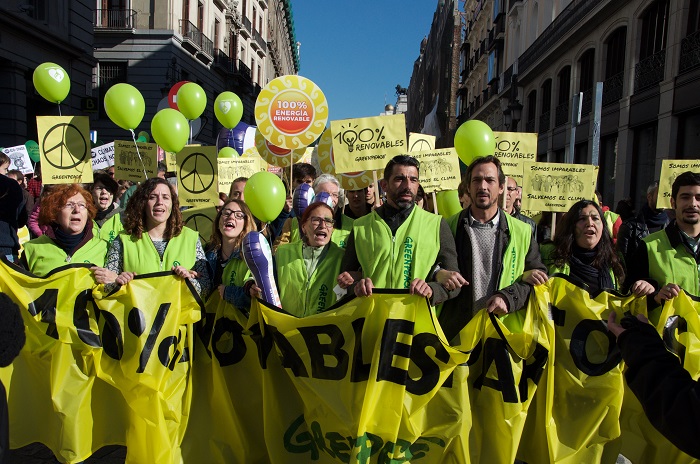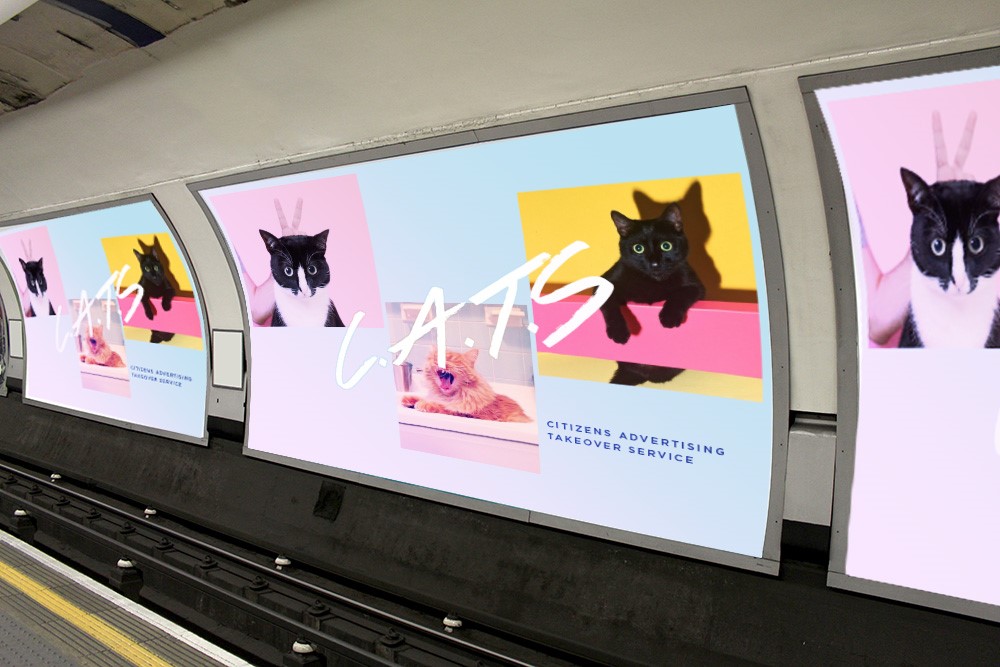Spotlight: James Turner, head of communications for the Arctic campaign at Greenpeace International
James Turner, head of communications for the Arctic campaign at Greenpeace International, speaks to us about his life as an activist, climbing the Bank of England as part of a protest after the financial crisis, the challenges of having a tight budget, why television still has the edge in getting messages into the public domain, and why creativity is at the heart of Greenpeace’s communications.
Before you became the head of communications at Greenpeace for the Arctic campaign you worked as a broadcast journalist and TV producer, how does that inform and influence the work you currently do?
I started my career on BBC Radio Newcastle in the North of England as a radio reporter and then I ended up reading the news on the radio. Soon after that I moved down to London and got a job as a producer on the Jonathan Dimbleby programme which at the time was ITV’s flagship politics show. That was my grounding in TV and also in political issues.
I’ve been at Greenpeace a lot longer than I was a journalist so it’s quite hard to reach back to my days as a journalist to think about how it informs the work I currently do, but when I joined Greenpeace it was quite easy to know what journalists were looking for when they called us. It also showed up in simple challenges like making sure that our press releases were accurate and suitable for journalists, and trying to figure out where the stories are in the Greenpeace world and how can we package them as effectively as possible. This can be quite challenging, so it takes someone with journalistic experience to pull out the newsworthy item and bring it to the top.
Have you always been passionate about the issues that Greenpeace champions?
There are some people at Greenpeace who were committed environmentalists from childhood but for me it was very much something that I came upon later in my life. Before I worked as a journalist I was pretty sure I would go into the advertising industry, so I’ve had quite an unconventional background for an activist or traditional environmentalist. I think what really drives me is not just the ecological imperative of protecting oceans and forests, but also the social aspect. We know now that there are elites of people in the world who are trying to use the system for their own ends, whether that’s massaging the data on climate change to confuse people or hiding large piles of money in offshore accounts so they don’t have to pay their dues to society. I think it’s that sense of injustice that drives me.
Do you consider yourself to be an activist?
Yes, I do consider myself to be an activist. It’s complicated because the word activist means lots of different things to different people. I’ve taken lots of direct action since working with Greenpeace, like climbing the bank of England as part of a protest just after the financial crisis. I did it because I wanted to encourage the Government to spend the stimulus package on renewable energy rather than sinking it back into the failed system that had got us into this mess.
I think activism is very broad and takes many forms. I think that anyone who steps a little bit out of their comfort zone to do something they believe in, whether that’s writing a letter to your elected MP or going to a climate change march or just speaking up with your friends, is an activist. It’s not cool to talk to about climate change, so if someone is known as that person who cares about these things and is outspoken I would say that they are an activist as well.
What are the challenges of being the head of communications at Greenpeace?
I suppose the really hard things are trying to operate on the same playing field as some of the world’s largest companies with a tiny fraction of their budget. Greenpeace rarely puts paid media out there. We do billboards, and TV adverts once in a while but that is the exception.
One challenge with platforms like Facebook, Twitter, and Instagram is trying to compete on social media with brands who are able to put paid promotion behind every post. If change-making organisations and charities want their fans to see their content they are going to have to pay in order to get it raised up the newsfeeds, and I worry what that means for the type of information people are receiving through social media and their exposure to issues that are perhaps non-commercial and don’t have a brand behind them.
How do you boil down issues like climate change to make people feel that they have the power to do something about it?
I guess there are two different ways of approaching this. The first is, what’s the call to action at the end of a piece of content? or if we have a spokesperson on TV, what are they asking the public to do? With any issue there is a way to break it down to the type of action someone can take. What we tend to do is make that a political ask with a clear outcome.
We also say, what they can do in their own lives? There are so many ways in which you can shift things with yourself and the community.
The most important is the second thing and that is how you make it feel relevant to them. We found that if you go in and talk about climate change in terms of and droughts, storms and floods, people are obviously concerned, but the way in which it’s often communicated makes it feel distant, impossible to eradicate, too remote. Instead we try to look at the local impact like the air pollution in London, which is also linked to climate change.
Making it relevant and a part of their everyday life is key. And it’s also about making these things feel hopeful and positive rather than relentlessly gloomy, and celebrating victories when we have them,
If we can get a handle on climate change we can have a stable environment to live in that is more equal and just for us all, so it’s really important to build those positive messages alongside those warnings.
Do you think the online world is more powerful and effective than the traditional media in getting the message out there?
I wouldn’t say it’s more effective at this point. I think television is still incredibly important for getting a message out there. If you want to reach millions of people at the drop of a hat, getting on ITV or BBC News is the most effective way to do it. But we are increasingly finding with the internet is that you can very quickly generate a global conversation that is unpredictable. Companies in the past might have had to deal with a few phone calls from Greenpeace supporters or perhaps supporters leaving letters on the doorstep, but now they are seeing tweets that are fully public mentioning their Twitter handles, asking what they are doing to say about deforestation in Indonesia. That conversation exists in the public domain forever and they have to deal with that problem.
Our goal isn’t to always reach as many people as possible. Often we have targeted communications at policy makers or CEOs, in which case it’s a very good idea to focus on the Daily Telegraph or the Financial Times, and that requires a different kind of approach and a different type of story.
How do you find content that is fresh to news networks?
It’s about putting creativity at the heart of our communications work. It’s about freeing up our own staff to apply creative thinking and creative processes to environmental challenges, and also collaborating with people outside the organisation, whether that is agencies, artists, comedians or filmmakers. We are in an incredibly lucky position in that a lot of people would like to work with Greenpeace and one of the things I try to do is broaden that network as wide as possible. As an example, we collaborated with a US comedy website and the actor Alexander Skarsgard. We took him up to the arctic and we shot the world’s first comedy series on the Arctic Ocean. It was very funny and I think that is a clever way of presenting the Artic issue without going through traditional news media outlets, using comedy as a way to seed that message. So, when I say it’s about creativity, it’s not just in the production of the content, but in the strategy behind it in terms of how you go about getting a message out there.
As an example, we collaborated with a US comedy website and the actor Alexander Skarsgard. We took him up to the arctic and we shot the world’s first comedy series on the Arctic Ocean. It was very funny and I think that is a clever way of presenting the Arctic issue without going through traditional news media outlets, using comedy as a way to seed that message. So, when I say it’s about creativity, it’s not just in the production of the content, but in the strategy behind it in terms of how you go about getting a message out there.
What are the vital ingredients of content that goes viral?
I definitely think that images or video have a power that words often can’t match. I do think that finding something with cultural relevance is very important, whether or not that is in the public conversation at the moment or is close to people’s hearts.
Finally, it is making sure your content is as emotionally compelling as possible. At Greenpeace we have started to understand that we can’t win by presenting facts to people, it’s important to target their heart strings and to speak to an emotional side of them.
Tell us about The Citizens Advertising Takeover Service (CATS) Kickstarter campaign that you’re currently working on?
This is a non-Greenpeace project so this is something that I have done in my spare time. The CAT project is the first project from Glimpse, which is a new collective of creative professionals of PR people who want to use their skills for good a little more often, not just when they get a charity brief once in a while or an opportunity to do something good within the framework of existing campaigns. What I am trying to think of is how we build an organisation from the ground up that uses creativity to make positive change in the world.
Our first project takes a look at consumerism and how do we get off this treadmill where all of us feel that buying things is going to make us happy when deep in our hearts we all know that the best things, the most lasting things in life, are free, like the relationships we have and the experiences we have in our lives. With the Glimpse project we tried to think about how we could transform a part of London which is very associated with commerce, new products, fashion, and transform it into something completely free, completely peaceful. It’s currently on Kickstarter and if we raise enough money we are going to replace all the adverts in an entire London tube station with pictures of Cats.
What’s your biggest achievement with working at Greenpeace?
I’ve worked on some fantastic projects but a highlight was definitely when Shell abandoned drilling in the Arctic following our campaign against it. There were obviously other factors that led to that decision but the level of public protest, the level of negative publicity certainly did play a part. Shifting the behaviour of a multi-national oil company, protecting a large part of the Arctic from oil drillings, has got to be right up there.








Leave a Comment